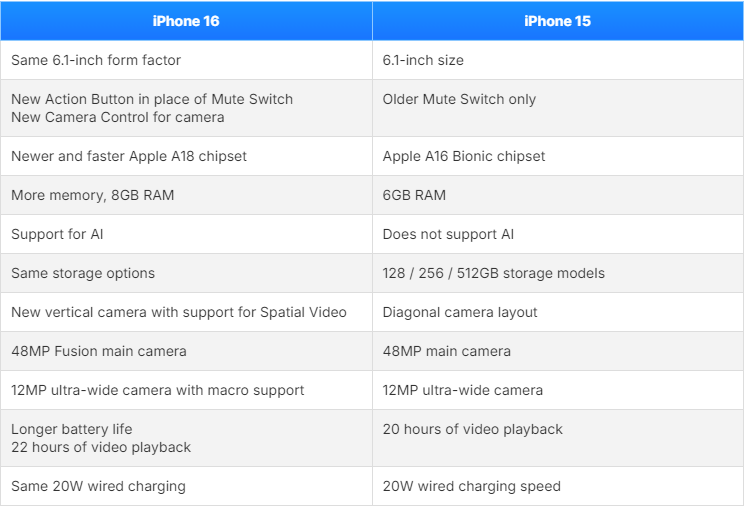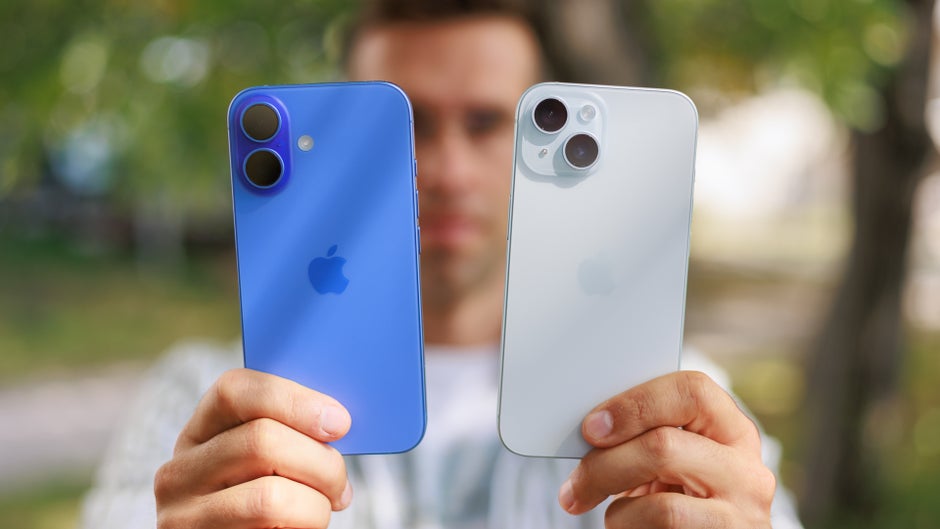Apple’s iPhones have long been the gold standard for innovation and design in the smartphone world. With each new release, they introduce exciting features that set the tone for the industry. The iPhone 15 brought with it impressive advancements, but now the iPhone 16 has emerged with promises of even more groundbreaking technology. Whether you’re thinking about upgrading or just curious about what’s changed, understanding the differences between the iPhone 15 and iPhone 16 is essential. Let’s dive into a detailed comparison to see how these two generations differ in terms of design, performance, camera technology,
and more.
iPhone 16 vs iPhone 15 differences

1. Design and Display: Subtle Refinements
When it comes to design, Apple has always maintained a sleek, minimalistic approach. Both the iPhone 15 and iPhone 16 follow this tradition, but there are subtle refinements in the newer model.
iPhone 15 Design:
The iPhone 15 kept the flat-edge design that was popularized with the iPhone 12, offering a sleek aluminum and glass body. It came in a range of appealing colors, maintaining Apple’s focus on aesthetics. The display featured a 6.1-inch and 6.7-inch OLED Super Retina XDR, depending on the model (iPhone 15 and iPhone 15 Plus/Pro).
iPhone 16 Design:
The iPhone 16, while not dramatically different in appearance, has taken the design further with improved ergonomics. The slightly slimmer bezels give the device a more modern, almost edge-to-edge display. While the form factor remains familiar, the iPhone 16 is made with a more durable titanium-aluminum alloy frame, making it lighter and more resistant to damage compared to the iPhone 15’s aluminum build. The display sizes remain the same (6.1-inch and 6.7-inch), but with an enhanced ProMotion display featuring a refresh rate of up to 120Hz even on the non-Pro models, delivering smoother scrolling and faster responsiveness.
Apple also introduced a more vibrant “Spectrum” color line-up for the iPhone 16, enhancing the hues with deeper saturation, making the design more eye-catching.
2. Performance: A Big Leap with the A18 Bionic
Apple’s proprietary chipsets have been key to their devices’ performance, and each year, we see improvements that lead to faster, more efficient phones.
iPhone 15 Performance:
Powered by the A16 Bionic chip, the iPhone 15 was no slouch in performance. The 6-core CPU, 5-core GPU, and 16-core Neural Engine made it perfect for gaming, photography, and everyday tasks. Its battery efficiency was improved over previous generations, and the device handled multitasking with ease. Still, the A16 chip was essentially a refined version of the A15, leaving some room for improvement.
iPhone 16 Performance:
The iPhone 16 takes a big leap forward with the introduction of the A18 Bionic chip. This new chipset features a 3nm architecture, making it more efficient and powerful than the 4nm A16. The A18 chip has an 8-core CPU, with two high-performance cores and six efficiency cores. This configuration allows the iPhone 16 to handle demanding applications, like high-end mobile gaming and professional-level video editing, with greater ease.
The 6-core GPU in the iPhone 16 is also enhanced with ray tracing support, giving users an ultra-realistic experience in gaming and AR (augmented reality) applications. Meanwhile, the new 18-core Neural Engine offers faster AI processing, making machine learning tasks (like photo editing, voice recognition, and augmented reality) faster and more accurate.
3. Camera System: Enhanced Photography and Videography
Apple’s camera technology is always a key talking point with every iPhone release. Both the iPhone 15 and iPhone 16 boast impressive cameras, but the newer model brings substantial improvements.
iPhone 15 Camera:
The iPhone 15 came equipped with a dual-camera system on the standard models and a triple-camera setup on the Pro versions. The 48MP main camera, introduced in the iPhone 14 Pro and retained in the iPhone 15, was capable of capturing incredible detail, even in low-light conditions. The Ultra-Wide camera was useful for landscape shots, while the Telephoto lens on the Pro models added versatility. The iPhone 15’s video capabilities also impressed, with ProRes support and Cinematic mode enhancing videography.
iPhone 16 Camera:
The iPhone 16 builds on this solid foundation, with improved computational photography and upgraded hardware. The primary camera on the iPhone 16 is still 48MP, but it now features an upgraded sensor with larger individual pixels, improving low-light performance and capturing more dynamic range.
One of the standout features of the iPhone 16 is its new AI-powered “Super Pixel Mode.” This mode combines multiple pixels into one to create even more detailed and vibrant images, especially in challenging lighting conditions. The Ultra-Wide camera also received a wider aperture, enhancing its low-light capabilities.
For the iPhone 16 Pro models, a new Periscope-style Telephoto lens was introduced, allowing up to 6x optical zoom, which is a significant upgrade from the 3x zoom on the iPhone 15 Pro. This new system dramatically enhances long-range photography while maintaining image clarity.
Apple also made improvements in video capture. The iPhone 16 supports 8K video recording at 24fps, bringing cinema-quality video to your pocket. Coupled with enhanced image stabilization and HDR10+ recording, the iPhone 16 is set to be a game-changer for content creators.
4. Battery Life and Charging: Efficiency Improvements
Battery life remains a critical consideration for iPhone users, and both models have made strides in this area, but the iPhone 16 leads the charge (pun intended) in terms of efficiency.
iPhone 15 Battery:
The iPhone 15 offered impressive battery life thanks to the efficiency of the A16 chip. Users could expect a full day of moderate use on a single charge. Fast charging support was available with both models, and Apple introduced USB-C for the first time, allowing for faster data transfer and charging.
iPhone 16 Battery:
Thanks to the 3nm A18 chip, the iPhone 16 is even more power-efficient, resulting in extended battery life. Apple claims up to two additional hours of usage compared to the iPhone 15. The iPhone 16 also supports faster 35W charging, cutting down charging times even further. Moreover, reverse wireless charging was introduced, allowing users to charge accessories like AirPods by placing them on the back of the phone.
5. Software and Features: iOS 17 vs iOS 18
Both the iPhone 15 and iPhone 16 run on iOS, but the latter benefits from the more advanced iOS 18, which brings several new features designed to enhance user experience.
iPhone 15 and iOS 17:
The iPhone 15 came with iOS 17, which introduced new features like StandBy (a customizable screen when the phone is charging in landscape mode), new Messages features, and improved privacy settings. It was a solid OS, offering a more refined experience over its predecessors.
iPhone 16 and iOS 18:
The iPhone 16 runs iOS 18 out of the box, which comes with several new features that leverage the phone’s enhanced hardware. A standout feature is the introduction of AI-driven personalized experiences, such as smarter Siri interactions and an upgraded Health app that tracks more in-depth metrics, including mental health monitoring. The lock screen customization options have been further expanded, and deeper integration with smart home devices makes the iPhone 16 a true hub for connected living.
Final Thoughts: Is the Upgrade Worth It?
The iPhone 16 brings notable improvements over the iPhone 15, particularly in performance, camera technology, and battery efficiency. If you’re someone who values cutting-edge technology, enhanced photography capabilities, or you rely heavily on your phone for creative tasks like video editing or gaming, the iPhone 16 may be a worthy upgrade.
For users of the iPhone 15, the improvements, while significant, may not be revolutionary enough to warrant an immediate upgrade unless you’re after the best of the best. But for those with older models, the iPhone 16 is a massive leap forward in performance, design, and features.
